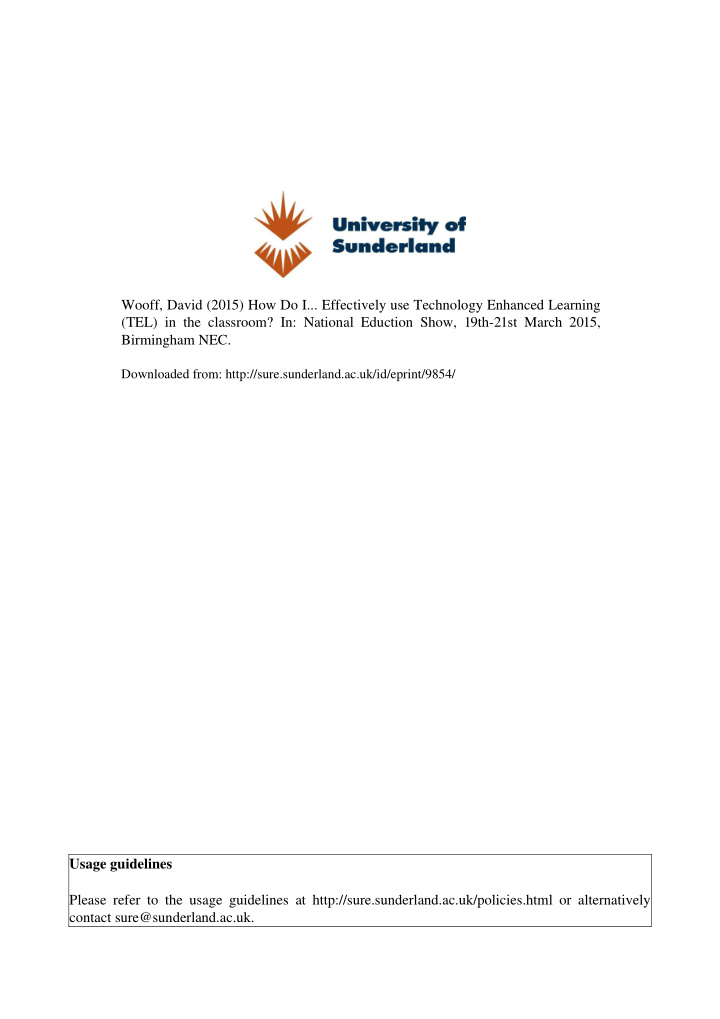



Wooff, David (2015) How Do I... Effectively use Technology Enhanced Learning (TEL) in the classroom? In: National Eduction Show, 19th-21st March 2015, Birmingham NEC. Downloaded from: http://sure.sunderland.ac.uk/id/eprint/9854/ Usage guidelines Please refer to the usage guidelines at http://sure.sunderland.ac.uk/policies.html or alternatively contact sure@sunderland.ac.uk.
How Do I... Effectively use Technology Enhanced Learning (TEL) in the classroom? David Wooff National Education Show 2015 1
Technology Enhanced Learning Technology Enhanced Teaching 2
Technology Enhanced Teaching Using technology to deliver something to a group of students that does not require them to engage technologically with the content, examples include: • PowerPoint Presentations • PREZi Presentations • Watching a Youtube video clip • Keynote • Slideshare 3
Advantages There are many advantages associated with technology enhanced teaching, some of these include: • Work can be easily saved, modified and shared • Can ensure uniformity between different classes • Lots of existing examples and exemplars which can be used as a starting point • Studies have shown that it can increase engagement of learners 4
Limitations There are a number of limitations and problems associated with Technology Enhanced Teaching: • Hardware Problems – lack of access to rooms with projectors for example. • Software problems, including lack of compatibility and errors which occur switching from PC to Mac based presentations • Issues with internet access (if it’s a cloud based programme like Prezi) 5
Limitations Over use - often called “ Death by PowerPoint ”. 6
Technology Enhanced Learning Learning that takes place when the learner (the pupil) is required to use technology to access original material that furthers (or reinforces) their understanding of something. 7
Advantages There are many advantages associated with technology enhanced learning, some of these include: • Information can be accessed in a unique way • Due to the technological interaction some pupils remember things better • Possible to do, and experience, things that cannot be done in lessons by any other means 8
Limitations There are a number of limitations and problems associated with Technology Enhanced Learning: • Volume and cost of hardware and software – eg. have you got enough tablets for each member of the class to have one? • Reliability; problems with battery life and wifi connections • Seen as a gimmick, and pupils get distracted from learning by the interaction with something technological • Staff knowledge and understanding to enable them to make use of the technology 9
Sources of Information 10
Reports into Technology Enhanced Learning 11
Books on Technology Enhanced Learning 12
• Quizzes Online Tools • Puzzles • Presentation Software • Repositories • Blogs • Survey Tools • Drawing Packages • Modelling Packages 13
Before we look at some examples that work: • Not all Technology Enhanced Teaching or Learning tools will be of use to you – technology in this case is supposed to ‘enhance’ learning so if it does not – do not use it. • Technology Enhanced Teaching and Learning applications introduced today will be superseded in around two years time, sometimes sooner! 14
QR Codes: • Quick Response (QR) Codes; originated from an industrial application developed by Toyota to enhance, and ultimately replace, barcodes, • Well established and reliable, • Multiple free QR Code generators for different platforms (iOS, Android, PC), • Multiple QR Code Readers available free, • Can work on printed or digital media 15
16
17
Augmented Reality Geographical Trigger (a landmark or place) Trigger Image 18
19
Augmented Reality – Generate Your Own ! 1. Down load Software 2. Determine Trigger (Place or Image) 3. Record or Obtain Video or Audio Item to link to trigger 4. Link Video or Audio Item to link to trigger 5. Upload Video or Audio Item to your own “channel” Work by Jennifer Jones, Bleak Hill Primary School. 20
Augmented Reality – Predefined 21
22
Augmented Reality Setting up your own channel: more time consuming, more practice and more learning required on the part of the teacher – but potentially more flexible, more focused and more relevant to exactly what you want Using predefined Augmented Reality: quick and very easy to use, reliable and repeatable – often have to find a way on incorporating existing outcomes into your learning environment. 23
Technology Enhanced Teaching (P (Presenting) • Why not use PowerPoint? • What advantages are there in using a cloud based piece of software? • Can all learners access the content? • Is this the “bulk” of the teaching resource, or does it need to be supplemented with a handout ? • How can learners access this information after the lesson /session? 24
Final Observations • Practice – make sure you know how to use it yourself, what the advantages are and what the limitations are • Rehearse in the same venue under the same conditions • Check the hardware and software to make sure it works; batteries are charged, internet access is available and wifi connections work • Ask yourself – does this enhance what I’m doing for the whole class and all learners within it? • Have a contingency; what if it doesn’t work? 25
Thanks for Listening David Wooff, Edge Hill University Ormskirk, L39 4QP Email: Wooffd@edgehill.ac.uk Twitter: @Destech2013 26
Recommend
More recommend